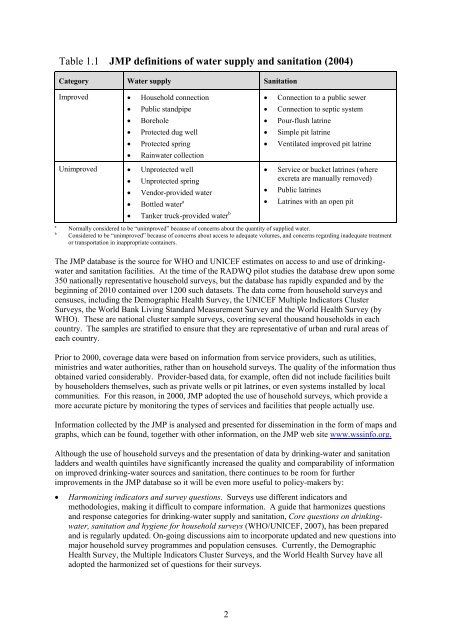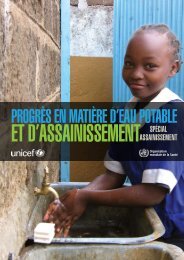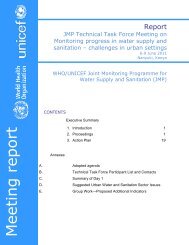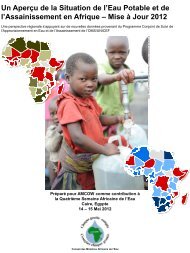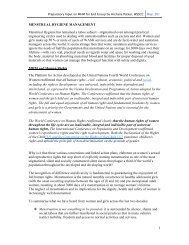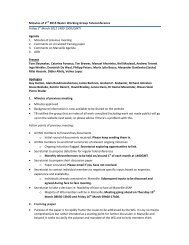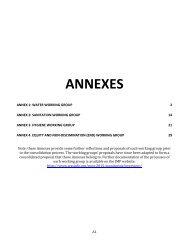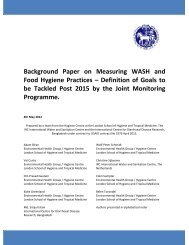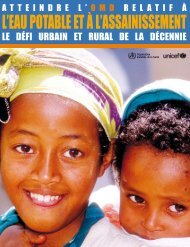rapid assessment of drinking-water quality in the republic of tajikistan
rapid assessment of drinking-water quality in the republic of tajikistan
rapid assessment of drinking-water quality in the republic of tajikistan
Create successful ePaper yourself
Turn your PDF publications into a flip-book with our unique Google optimized e-Paper software.
a<br />
b<br />
Table 1.1 JMP def<strong>in</strong>itions <strong>of</strong> <strong>water</strong> supply and sanitation (2004)<br />
Category Water supply Sanitation<br />
Improved Household connection<br />
<br />
<br />
<br />
<br />
<br />
Public standpipe<br />
Borehole<br />
Protected dug well<br />
Protected spr<strong>in</strong>g<br />
Ra<strong>in</strong><strong>water</strong> collection<br />
<br />
<br />
<br />
<br />
<br />
Connection to a public sewer<br />
Connection to septic system<br />
Pour-flush latr<strong>in</strong>e<br />
Simple pit latr<strong>in</strong>e<br />
Ventilated improved pit latr<strong>in</strong>e<br />
Service or bucket latr<strong>in</strong>es (where<br />
Unimproved Unprotected well<br />
Tanker truck-provided <strong>water</strong> b<br />
Unprotected spr<strong>in</strong>g<br />
excreta are manually removed)<br />
Vendor-provided <strong>water</strong><br />
Public latr<strong>in</strong>es<br />
Bottled <strong>water</strong> a<br />
Latr<strong>in</strong>es with an open pit<br />
Normally considered to be “unimproved” because <strong>of</strong> concerns about <strong>the</strong> quantity <strong>of</strong> supplied <strong>water</strong>.<br />
Considered to be “unimproved” because <strong>of</strong> concerns about access to adequate volumes, and concerns regard<strong>in</strong>g <strong>in</strong>adequate treatment<br />
or transportation <strong>in</strong> <strong>in</strong>appropriate conta<strong>in</strong>ers.<br />
The JMP database is <strong>the</strong> source for WHO and UNICEF estimates on access to and use <strong>of</strong> <strong>dr<strong>in</strong>k<strong>in</strong>g</strong><strong>water</strong><br />
and sanitation facilities. At <strong>the</strong> time <strong>of</strong> <strong>the</strong> RADWQ pilot studies <strong>the</strong> database drew upon some<br />
350 nationally representative household surveys, but <strong>the</strong> database has <strong>rapid</strong>ly expanded and by <strong>the</strong><br />
beg<strong>in</strong>n<strong>in</strong>g <strong>of</strong> 2010 conta<strong>in</strong>ed over 1200 such datasets. The data come from household surveys and<br />
censuses, <strong>in</strong>clud<strong>in</strong>g <strong>the</strong> Demographic Health Survey, <strong>the</strong> UNICEF Multiple Indicators Cluster<br />
Surveys, <strong>the</strong> World Bank Liv<strong>in</strong>g Standard Measurement Survey and <strong>the</strong> World Health Survey (by<br />
WHO). These are national cluster sample surveys, cover<strong>in</strong>g several thousand households <strong>in</strong> each<br />
country. The samples are stratified to ensure that <strong>the</strong>y are representative <strong>of</strong> urban and rural areas <strong>of</strong><br />
each country.<br />
Prior to 2000, coverage data were based on <strong>in</strong>formation from service providers, such as utilities,<br />
m<strong>in</strong>istries and <strong>water</strong> authorities, ra<strong>the</strong>r than on household surveys. The <strong>quality</strong> <strong>of</strong> <strong>the</strong> <strong>in</strong>formation thus<br />
obta<strong>in</strong>ed varied considerably. Provider-based data, for example, <strong>of</strong>ten did not <strong>in</strong>clude facilities built<br />
by householders <strong>the</strong>mselves, such as private wells or pit latr<strong>in</strong>es, or even systems <strong>in</strong>stalled by local<br />
communities. For this reason, <strong>in</strong> 2000, JMP adopted <strong>the</strong> use <strong>of</strong> household surveys, which provide a<br />
more accurate picture by monitor<strong>in</strong>g <strong>the</strong> types <strong>of</strong> services and facilities that people actually use.<br />
Information collected by <strong>the</strong> JMP is analysed and presented for dissem<strong>in</strong>ation <strong>in</strong> <strong>the</strong> form <strong>of</strong> maps and<br />
graphs, which can be found, toge<strong>the</strong>r with o<strong>the</strong>r <strong>in</strong>formation, on <strong>the</strong> JMP web site www.wss<strong>in</strong>fo.org.<br />
Although <strong>the</strong> use <strong>of</strong> household surveys and <strong>the</strong> presentation <strong>of</strong> data by <strong>dr<strong>in</strong>k<strong>in</strong>g</strong>-<strong>water</strong> and sanitation<br />
ladders and wealth qu<strong>in</strong>tiles have significantly <strong>in</strong>creased <strong>the</strong> <strong>quality</strong> and comparability <strong>of</strong> <strong>in</strong>formation<br />
on improved <strong>dr<strong>in</strong>k<strong>in</strong>g</strong>-<strong>water</strong> sources and sanitation, <strong>the</strong>re cont<strong>in</strong>ues to be room for fur<strong>the</strong>r<br />
improvements <strong>in</strong> <strong>the</strong> JMP database so it will be even more useful to policy-makers by:<br />
<br />
Harmoniz<strong>in</strong>g <strong>in</strong>dicators and survey questions. Surveys use different <strong>in</strong>dicators and<br />
methodologies, mak<strong>in</strong>g it difficult to compare <strong>in</strong>formation. A guide that harmonizes questions<br />
and response categories for <strong>dr<strong>in</strong>k<strong>in</strong>g</strong>-<strong>water</strong> supply and sanitation, Core questions on <strong>dr<strong>in</strong>k<strong>in</strong>g</strong><strong>water</strong>,<br />
sanitation and hygiene for household surveys (WHO/UNICEF, 2007), has been prepared<br />
and is regularly updated. On-go<strong>in</strong>g discussions aim to <strong>in</strong>corporate updated and new questions <strong>in</strong>to<br />
major household survey programmes and population censuses. Currently, <strong>the</strong> Demographic<br />
Health Survey, <strong>the</strong> Multiple Indicators Cluster Surveys, and <strong>the</strong> World Health Survey have all<br />
adopted <strong>the</strong> harmonized set <strong>of</strong> questions for <strong>the</strong>ir surveys.<br />
2


